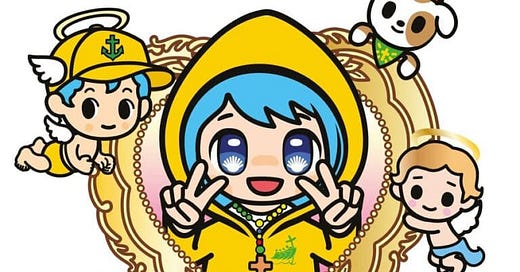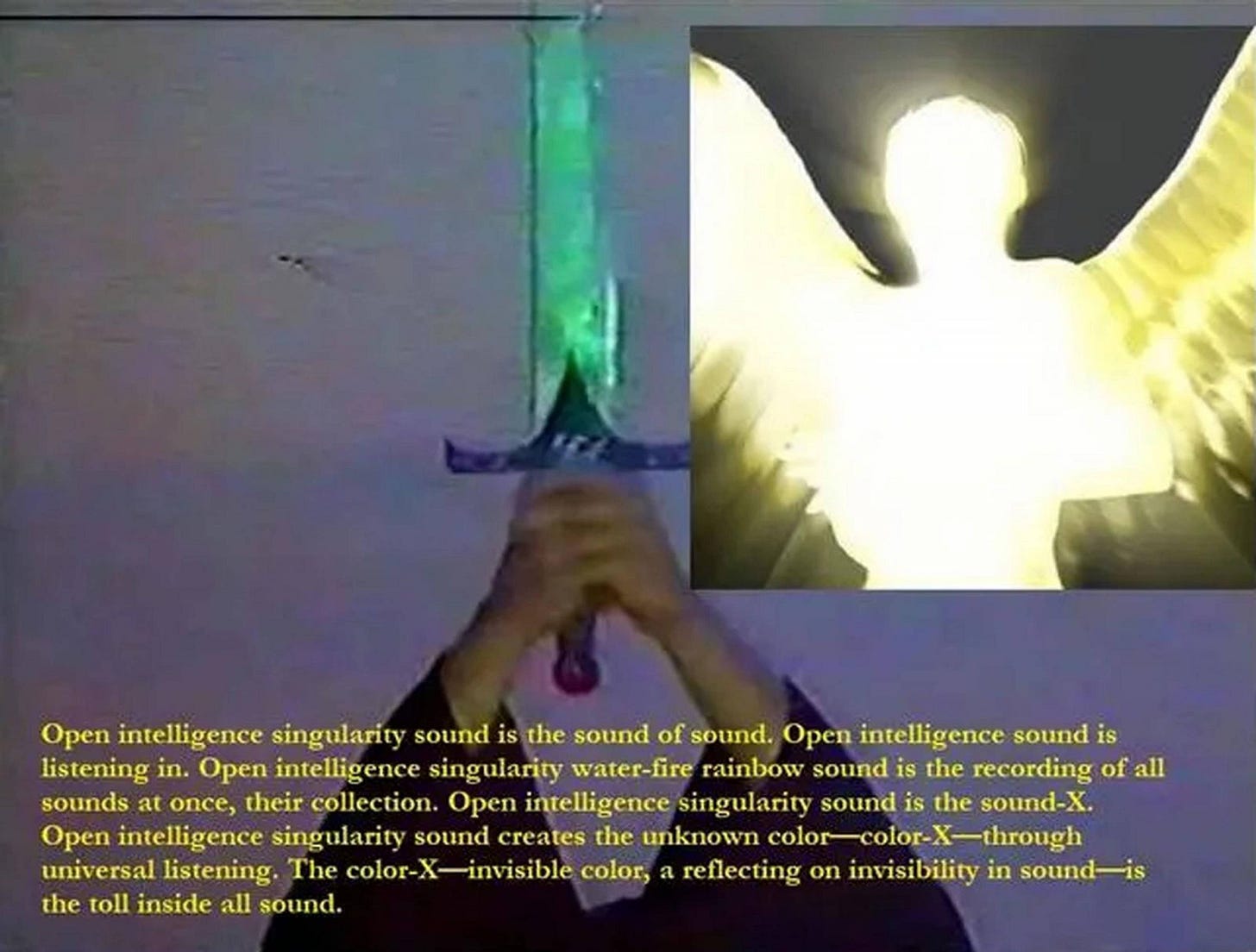They Put a Milady in the Vatican
On anime and angels, Remilia Corporation, and cute accelerationism
When I first saw the image, I thought it was a meme; an elder Vatican cardinal gesturing toward a smiling, chibi-style anime character with big eyes and blue hair.
Her name is Luce, and she was unveiled this week as the mascot for the Vatican’s 2025 Jubilee Year along with a cast of other anime friends, and was designed by the Italian, kawaii-inspired brand tokidoki. Archbishop Rino Fisichella, the Vatican’s chief organizer for the jubilee, stated that Luce embodies the Catholic Church’s desire "to live even within the pop culture so beloved by our youth."
On Angels and Anime
To those chronically online, the Vatican’s move feels particularly strategic (although likely accidentally so), given the resurgence of Catholicism and anime aesthetics in adjacent online communities. Luce looks uncannily like a Milady, a series of NFTs created by the enigmatic online art collective Remilia Corporation, whose ideology is an esoteric blend of spirituality, meme culture, and cuteness—and whose members have also been associated with extremist ideas and involved in controversy.
Since around 2021, there’s been a noticeable rise in religious content online, especially within younger, more reactionary circles. I believe this trend is driven by a convergence of several factors: (1) a rightward shift toward traditional value systems, (2) a desire for belief in a post-truth world that increasingly feels opaque and fragmented, (3) the resonance of mystical, religious imagery with a technologically-mediated reality that often feels both magical and absurd, and 4) the aesthetics are, simply put, based. I’ll explore some of the key aesthetic and cultural connections within this online nexus of religion and reactionary thought to explain how anime has come to align so closely with Catholicism, at least in certain communities.
Perhaps the most mainstream of the religious aesthetics emerging from post-pandemic reactionary ideology is the “tradcath” or “traditional Catholic” aesthetic. What began as an ironic adoption of Catholic style and tradition has evolved into a genuine belief system for many. Tradcath imagery is pervasive online, from TikTok videos of girls in long lace veils to Pinterest boards featuring women in white dresses, rosaries in hand. Discussions around “tradwives” continue to spawn on platforms like X and Reddit.
Around the same time tradcath was gaining traction in the early post-COVID days, a related, more mythical, edgelordier aesthetic was also emerging online. Popularized by the pseudonymous Substack writer angelicism01—a prophet of the same reactionary, downtown NY scene—this aesthetic alternates between ethereal images of angels and knights in armor and photos of East Asian girls overlaid with cryptic, surreal messages, and content that leaned heavily into a romanticization of apocalypse and extinction.
By this point, in the early 2020s, anime art had been popular for decades, particularly among techy, chronically-online Gen Zs, but as reactionary subcultures gained more traction online, their aesthetics began to cross-pollinate. Anime imagery was absorbed into the trend of esoteric schizoposting in what was 1) a related aesthetic move to the appropriation of images of East Asian girls that was happening at the time (which was sparked by fascination with 2015 Art Basel stabber Siyuan Zhao’s mugshot), and 2) a resonance between the exaggerated stylization of anime and the chaotic, distortionary milieu of the internet. This adoption of anime-style imagery pushed the subculture in a more hyperreal, hyper-cute direction—perhaps best exemplified in the Miladys. As angelicism01 writes on the Miladys’ aesthetic influences, “these image-contracts are obviously the inheritance of the Miya Siyuan Zhao pfp proliferation that peaked between 2019 and 2020.”
The experimental art collective Remilia Corporation released a line of NFTs called Milady Maker in 2021, featuring 10,000 pfp-style images of cute, neo-chibi anime characters with exaggerated features—large eyes and heads, small bodies, pastel-colored hair. Since then, a substantial body of art has emerged online in the style of the Miladys, frequently juxtaposing the characters with imagery evoking either violence, such as flames and weapons, or celestial themes, including fluffy clouds and iridescent angels.
The collective faced scrutiny in 2022 when it was revealed that founder Charlotte Fang, under the pseudonym Miya, had posted racist and extremist messages online, though they later claimed these posts were satirical performance art. Despite the backlash and since Charlotte Fang’s distancing from the project, Remilia’s cultural influence has only grown—along with the price of the NFTs—amassing a distinct presence on X among members and followers, who use Miladys as their profile pictures and often schizopost in a recognizable format.
What sets Remilia Corporation apart is its radically new approach to internet art, leveraging the internet’s inherent mechanics—anonymity, decentralization, virality—to disseminate its imagery memetically. Drawing from meme culture, it rejects traditional notions of authorship and credit, and considers the online post an artistic act in itself. But beyond this, Remilia espouses an all-consuming relationship with the medium of the internet, a complete immersion in its culture, aesthetics, and modes of production, as if online was the whole of reality and platform mechanics were the fundamental rules of existence. The collective terms this “networked spirituality” and defines it as:
Network spirituality is the futurist embrace of experiential hyperreality found in the web's accelerated networks, a lens in which to efficiently (& safely) engage lucid virtuality, and the internalization of its new cultural modes and mores.
Though the esoteric school also furthers a lainist occultism around persona-egregores, positing the development of genuine spiritual entities spontaneously self-organized as hyperreal entities in the catalyzed collective consciousness, veritable deities: network angels & demons.
Given Remilia’s less-than-holy reputation and its relative obscurity outside of niche circles, the chances are slim to none that the Catholic Church’s strategists intended to put a Milady in the Vatican. It’s just that the online zeitgeist sometimes manifests into real life through strange channels, and that the connection between Catholicism and anime may be stronger than it first appears. But what the Vatican definitely taps into with Luce—just as the Miladys do so well—is the power of cuteness.
On Cuteness and the Inhuman
In their book Cute Accelerationism, which came out earlier this year, CCRU-affiliated theorists Amy Ireland and Maya B. Kronic present a philosophical exploration of contemporary cuteness.
Cuteness is about contagion, they write. Try interacting with a baby or a kitten without yourself adopting certain mannerisms, softening your voice, becoming cute yourself. Through this contagious quality, cuteness not only dissolves the boundaries between subject and object, but its viral potential makes it especially suited to memetic spread, thriving in the fluid, algorithm-driven landscape of online networks.
In fact, the internet incentivizes the creation of more and more extreme forms of cuteness. Cuteness accelerates and intensifies online into configurations more remixed, more distorted, more synthetic—but towards what? Cuteness is accelerationist, Ireland and Kronic argue, in that it orients us toward an alien future that we cannot see from the present.
Cuteness, in its artificiality, takes on an inhuman quality. This is why anime, with its exaggerated forms, resonates so well within the ethos of the internet. It also renders cuteness a fitting aesthetic for another kind of inhumanity—the angelic—which likewise exists externally to the physical world. The aesthetic resonance between anime and the angelic reflects a mutual engagement with an alterity that exceeds normative human experience.
Incidentally, just a few months before Cute Accelerationism was released and with no relation, a Remilia-affiliated group called Based Retard Gang shared an online memo called the CUTE/ACC Manifesto, in which they propose their own understanding of cuteness. In it, they write:
Milady exemplifies the serenity, love and simplicity of CUTE/ACC. The truth of what is yet to come is palpable in Milady’s gaze alone, sheltered in twinkling irises like a prophecy. The new gaze of the neo-kawaii, neo-chibi, neo-Doujin future is a beautiful stare that contains within it all that can be said and also everything that is unsayable.
Cuteness and beauty are real, they affirm. No meaning, no explanations needed. Cuteness cuts to the core of experience.
With collectives like these, it’s difficult to discern how much of their online presence reflects genuine commitment to the ideas they preach and how much is performative edginess aimed at financial gain. BRG’s agenda, for instance, seems to involve shilling memecoins and SoundCloud links (which, to be fair, aligns with their “accelerationist” stance). But I also think the exercise of trying to parse between what’s genuine and what’s performative is no longer relevant, and that’s part of the point. Subcultures like these dissolve the distinction between truth and irony, mythmaking and hyperfinancialization, flattening all content and collapsing it all onto an equal plane. Truth no longer matters. Contagion does. But we already knew that about the internet. Movements like Remilia are reimagining art along these lines.
In the days following her unveiling, response to Luce has been overwhelmingly positive. After all, she’s so cute. And as the CUTE/ACC Manifesto affirms: Being Cute Is Literally All That Matters.












